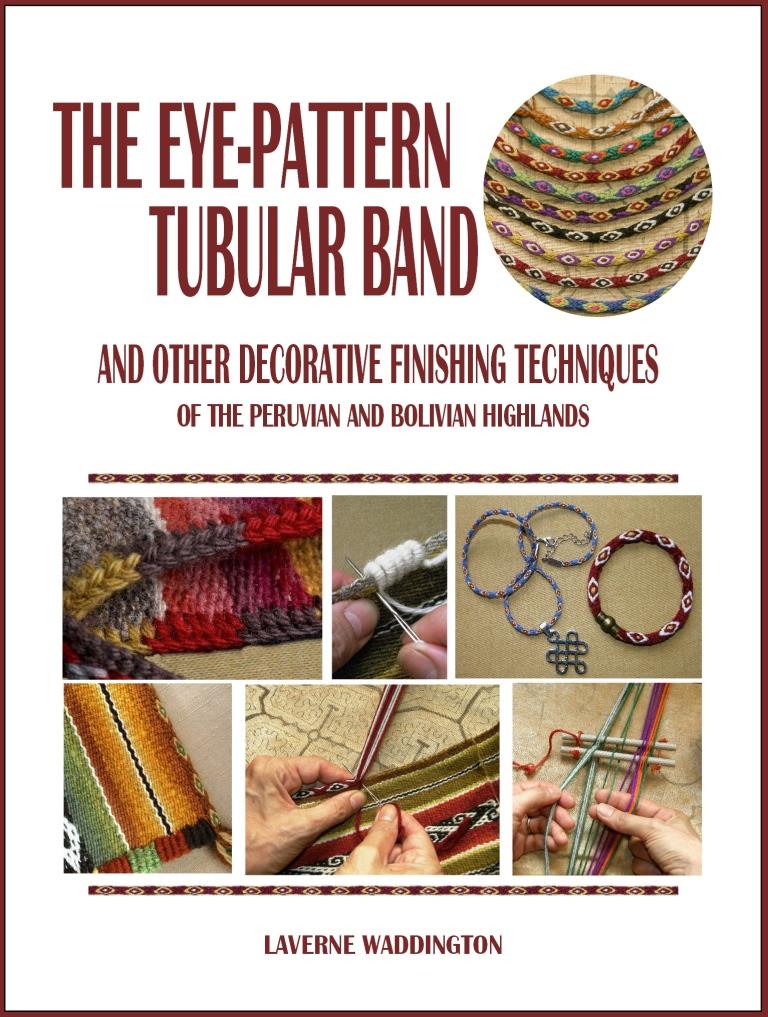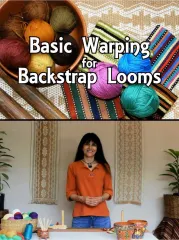I am going to start this new page on my blog on Structures and Terminology with a short explanation of what is meant by “complementary warp pick-up”. You will probably run into this term when you read about warp-faced backstrap weaving. Andean pebble weave is just one of the techniques that falls into this category.
The idea here is not to teach you a specific weaving technique or pattern but simply to show you how some weavers pick up the warps to form their patterns when weaving a complementary-warp structure. Irene Emery defines complementary weaves as those where “two sets of elements play equivalent and reciprocal parts on opposite faces of the fabric,”….
This creates a double-faced fabric. The design on one face of the fabric is mirrored on the other face with its colors reversed as in the Andean pebble weave example below.
 When weaving a complementary-warp structure, the warp arrangement in its simplest form will be as seen above. Two colors are arranged in two sheds as seen above. The warps in one color will go into string heddles and the other color will be controlled by a shed rod. In the example above, each black warp has a red partner. I call one black warp together with its red partner a “complementary pair”. In the example, the black warp sits on the right of its red partner. I have separated two complementary pairs from the rest of the warps so you can see how they lie. If I were to weave this two-shed warp arrangement in plain weave, I would create a band with horizontal bars in red and black.
When weaving a complementary-warp structure, the warp arrangement in its simplest form will be as seen above. Two colors are arranged in two sheds as seen above. The warps in one color will go into string heddles and the other color will be controlled by a shed rod. In the example above, each black warp has a red partner. I call one black warp together with its red partner a “complementary pair”. In the example, the black warp sits on the right of its red partner. I have separated two complementary pairs from the rest of the warps so you can see how they lie. If I were to weave this two-shed warp arrangement in plain weave, I would create a band with horizontal bars in red and black.
 Weavings like these Jalq’a textiles above from Potolo, Bolivia have been woven using a complementary-warp structure using red and black threads on a warp that would have looked like my examples above. You can see that the faces of the textiles show red figures on a black background. The back of the textile will show the same figures except that they will be black on a red background.
Weavings like these Jalq’a textiles above from Potolo, Bolivia have been woven using a complementary-warp structure using red and black threads on a warp that would have looked like my examples above. You can see that the faces of the textiles show red figures on a black background. The back of the textile will show the same figures except that they will be black on a red background.
The pick-up is done with the aid of a cross that separates the colors and keeps them in strict order. If the weaver wants black to show on the upper face of her weaving she will pick up and keep the black using her hands, a stick or other tool and drop its red partner. The dropped red will show on the back of the textile.
The way weavers choose to form the cross and carry out the pick-up varies greatly from region to region. There is no one correct way to do it.
 Above, you can see two weavers from Potolo with their red and black weavings. The first weaver has created a ”picking cross” down at the weaving line. She has a stick under all the red warps and has opened up the shed with all the black warps. Her places her hand under the black warps as she picks the pattern. From this cross she will select the colors she needs. When she picks a red she will drop its black partner and vice versa. Like this, she will create a shed of both red and black warps through which she will pass the weft.
Above, you can see two weavers from Potolo with their red and black weavings. The first weaver has created a ”picking cross” down at the weaving line. She has a stick under all the red warps and has opened up the shed with all the black warps. Her places her hand under the black warps as she picks the pattern. From this cross she will select the colors she needs. When she picks a red she will drop its black partner and vice versa. Like this, she will create a shed of both red and black warps through which she will pass the weft.
The weaver on the right is doing likewise except that she has inserted a stick under the black warps and has opened the shed with the reds. This will be the next step in the process for the weaver on the left. From this “picking cross” she will select the warps for her design.
Both weavers are using sticks to pick up the warps.
 This weaver from Tinkipaya, Bolivia uses her hands to pick and drop the warps for her design. Her weaving has bands of many colors. She has a permanent cross in her warp. You can probably just make it out in the picture. Two cords are holding her cross rather than sticks. She is working her way across the warp picking the color from one side of the cross which she wants to have showing on the front of the weaving and dropping the complementary partner in the other color which will show on the back of the weaving.
This weaver from Tinkipaya, Bolivia uses her hands to pick and drop the warps for her design. Her weaving has bands of many colors. She has a permanent cross in her warp. You can probably just make it out in the picture. Two cords are holding her cross rather than sticks. She is working her way across the warp picking the color from one side of the cross which she wants to have showing on the front of the weaving and dropping the complementary partner in the other color which will show on the back of the weaving.
This is the way I was taught to do pebble weave in one region of Peru….picking from a permanent cross with my hands. The pick-up method varies from region to region.
Here is a video that I made showing the theory of complementary warp pick-up. This is how I pick one pattern shed of red and black warps through which I will pass the weft to form my design.
Here are several video clips of Bolivian weavers from Potolo, Isoso, Tarabuco and Tinkipaya doing complementary-warp pick-up. See the hundreds of threads they are working with and see how fast they go! The first weaver you will recognize from Potolo, followed by a Guaraní weaver from Isoso, a lady from Tarabuco and one from Tinkipaya.
The second weaver in this video is my Guaraní weaving teacher here in Santa Cruz. The Guaraní weavers have their own very special way of doing the pick-up and are the only ones I have seen who don’t pick from a static cross when doing complementary-warp pick-up. Angela has her two colors, brown and white, separated into two sets of string heddles and simply pulls on the appropriate heddle when she needs a color. Somehow she manages to keep her complementary pairs in order and doesn’t mix up or cross the threads!
Well, I hope that these videos and explanations have been interesting for you. Those who have my Andean Pebble Weave book may like to see the theory of the pick-up I am describing therein with step-by-step pictures, in action here in my video. Note that none of the weavers in these videos are doing pebble weave. Pebble weave is just one of several techniques that fall into this complementary warp category.
My Complementary-warp Pick-up e-book teaches a pick-up method that can be used for all structures that fall into the Complementary-warp category, not only Andean Pebble Weave. Any loom that can produce two basic sheds and warp-faced bands can be used. My Andean Pebble Weave on Inkle Looms e-book teaches methods that I designed specially for those who like to use the standard inkle loom.





















I appreciate seeing these different ways of selecting warp threads for complementary warp weaving. The speed and deftly articulated motions are impressive…..practice and repetition make such a difference. At this point I’m happy if I can simply select the RIGHT warps each time! Thanks for creating this new part of your blog to delineate various weave structures and the terminology that is employed.
By: lausanneha on February 14, 2014
at 2:46 am
Thanks so much for filming these terrific weavers and for posting it. It. Is amazing how quickly they work and how fine their threads are.
Bettylou
By: Bettylou on August 17, 2015
at 3:09 pm
HI! Thanks so much for posting these videos…it helped to clarify for me how to “pick up.” Would you be willing to speak to various tips and tricks for keeping the warp threads straight and their partners in order?
By: tbunnyd on January 2, 2016
at 3:23 am
The key is the ”picking cross” that I mention several times in the description. That is what keeps the threads in order. If you attempt to do the pick-up for complementary-warp patterning without some kind of cross, you risk picking the wrong partner thread as there is no cross to force the threads to sit in their correct order. My Guarani teacher, whom you see in the video working on a vertical loom, is the only weaver I have come across who does not use a picking cross.
By: lavernewaddington on January 2, 2016
at 2:15 pm
Hi!
Can’t thank you enough for the english vocabulary I’ve been looking for like mad.
The translation from spanish to english is very difficult.
You’ve made may day 🙂
By: Berta Borquez on May 15, 2020
at 9:59 pm
Thank you for letting me know! It’s always nice to know when people find this content useful.
By: lavernewaddington on May 17, 2020
at 8:22 pm